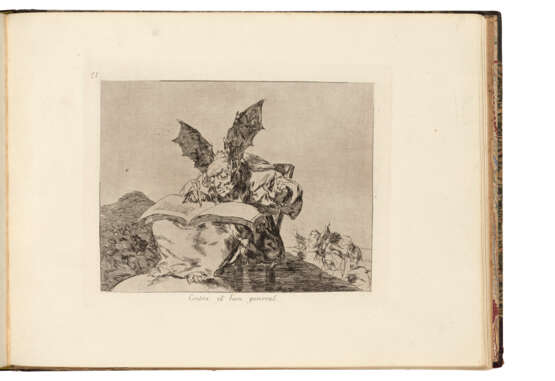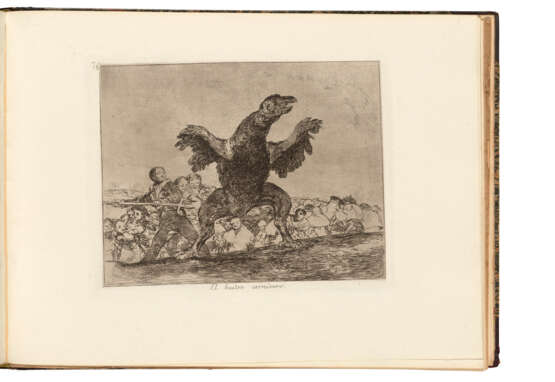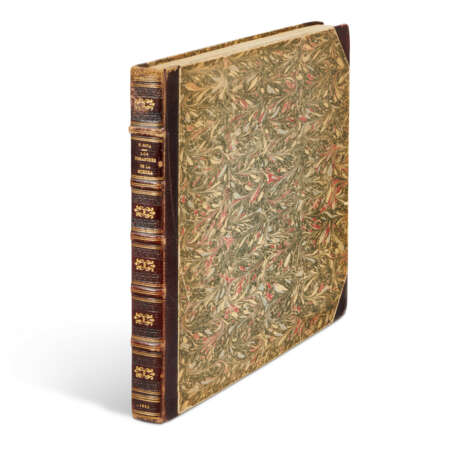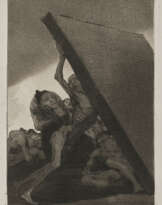ID 794561
Lot 200 | GOYA Y LUCIENTES, Francisco de (1746-1828)
Valeur estimée
£ 30 000 – 40 000
Los Desastres de la Guerra. Madrid: Real Academia de Nobles Artes de San Fernando, 1863.
The first edition of Goya's impassioned 'Disasters of War.' When in 1807 French troops started to flood into Spain and the country quickly descended into a chaotic and bloodthirsty war, Goya’s highly ambiguous dictum 'El sueño de la razon produce monstruos' must have felt like a prophesy. The phrase, published in Los Caprichos in 1799 seemed to describe the aftermath of the French Revolution and the rise of Napoleon perfectly: the dream of reason had indeed produced monsters. Whether Goya was too disillusioned or just too pragmatic to openly take sides is impossible to tell. In the course of the Peninsular War, he painted a portrait of the French General Guye, received commissions and the Royal Order from Joseph Bonaparte and, when all was over, portrayed the victorious Duke of Wellington. In 1808, right at the beginning of the conflict, the Spanish General Palafox invited the artist to travel to Saragossa to depict the ruined city and immortalise the people, who had so courageously defended it during the siege by the French. It may have been during this journey across the war-torn country that Goya first thought of creating a series of prints about the war.
The Disasters of War, as we know the series today, was created by Goya presumably over the course of ten years and in three distinct phases. The earliest plates, some of which bear the date 1810, depict scenes from the actual war, the battles and skirmishes, the executions, rapes and mutilations, the wounded and the dead. The second group concentrates on the famine caused by the war in 1811-12, which left tens of thousands of Madrileños dead. The third and final part consists of a group of grotesques, satires and allegories reminiscent of Los Caprichos, expressing Goya’s disdain for Fernando VII’s reactionary and vengeful rule after he had regained power following Napoleon’s defeat in 1814. It seems likely that Goya had wanted to publish the first two groups of etchings in 1814, but was prevented from doing so by Fernando’s post-war tyranny. In 1820, the revolt of Rafael del Riego and the restoration of the liberal Constitution promised liberty at last. It may have been then that Goya once again thought of publishing the series and complemented it with the caprichos enfaticos, as he called them. Yet three years later, Fernando’s absolute rule was re-established, General Riego was executed and Goya soon emigrated to France. Los Desastres de la Guerra were never published in his lifetime. When the fight for freedom was over and won, and victory had brought nothing but Fernando’s vindictive restoration, Goya certainly seemed to have lost all faith. One of the caprichos enfaticos at the end of the series (plate 69) shows a skeleton scribbling one single word as it sinks into the grave: Nada ('Nothing'). This is the second issue of the first edition, with captions corrected. Harris 121-200, 1b.
Oblong folio (254 x 340mm sheets). Lithographic title with place and date in ink manuscript, 2pp. letterpress biographical essay, the complete set of 80 etchings with burnished aquatint, drypoint and engraving on heavy wove paper, 31 with part of a J.G.O. and Palmette watermark, the rest without watermark, with margins (title, letterpress and first plate very faintly browned, otherwise the plates clean and fresh). Contemporary purple straight-grained half morocco over marbled-paper covered boards, marbled endpapers (front free endpaper loose, extremities lightly rubbed, head of spine slightly more heavily).
Special notice
No VAT on hammer price or buyer's premium.
| Artiste: | Francisco de Goya (1746 - 1828) |
|---|---|
| Lieu d'origine: | Europe, Espagne |
| Catégorie maison de vente aux enchères: | Livres imprimés |
| Artiste: | Francisco de Goya (1746 - 1828) |
|---|---|
| Lieu d'origine: | Europe, Espagne |
| Catégorie maison de vente aux enchères: | Livres imprimés |
| Adresse de l'enchère |
CHRISTIE'S 8 King Street, St. James's SW1Y 6QT London Royaume-Uni | |
|---|---|---|
| Aperçu |
| |
| Téléphone | +44 (0)20 7839 9060 | |
| Commission | see on Website | |
| Conditions d'utilisation | Conditions d'utilisation |














